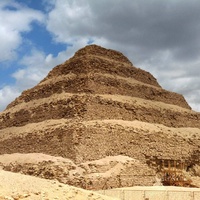Search from various English teachers...
AnatolyG•VoiceUnlock
Professional TeacherContinuing with the podcast on IELTS Reading & Comprehension & Listening.
The Step Pyramid of Djoser Part 2.
D
When finally completed, the Step Pyramid rose 62 meters high and was the tallest structure of its time. The complex in which it was built was the size of a city in ancient Egypt and included a temple, courtyards, shrines, and living quarters for the priests. It covered a region of 16 hectares and was surrounded by a wall 10.5 meters high. The wall had 13 false doors cut into it with only one true entrance cut into the south-east corner; the entire wall was then ringed by a trench 750 meters long and 40 meters wide. The false doors and the trench were incorporated into the complex to discourage unwanted visitors. If someone wished to enter, he or she would have needed to know in advance how to find the location of the true opening in the wall. Djoser was so proud of his accomplishment that he broke the tradition of having only his own name on the monument and had Imhotep’s name carved on it as well.
E
The burial chamber of the tomb, where the king’s body was laid to rest, was dug beneath the base of the pyramid, surrounded by a vast maze of long tunnels that had rooms off them to discourage robbers. One of the most mysterious discoveries found inside the pyramid was a large number of stone vessels. Over 40,000 of these vessels, of various forms and shapes, were discovered in storerooms off the pyramid’s underground passages. They are inscribed with the names of rulers from the First and Second Dynasties of Egypt and made from different kinds of stone.
Continuing below.

Cambridge IELTS Reading & Comprehension. The Step Pyramid of Djoser Part 2
May 23, 2022 8:58 AM
Comments · 3
Questions 25-26
Choose TWO letters, A-E.
Write the correct letters in boxes 25 and 26 on your answer sheet.
Which TWO of the following points does the writer make about King Djoser?
A Initially he had to be persuaded to build in stone rather than clay.
B There is disagreement concerning the length of his reign.
C He failed to appreciate Imhotep’s part in the design of the Step Pyramid.
D A few of his possessions were still in his tomb when archaeologists found it.
E He criticised the design and construction of other pyramids in Egypt.
May 23, 2022
Questions 14-20
Reading Passage 2 has seven paragraphs, A-G.
Choose the correct heading for each paragraph from the list of headings below.
Write the correct number, i-ix, in boxes 14-20 on your answer sheet.
List of Headings
i The areas and artefacts within the pyramid itself
ii A difficult task for those involved
iii A king who saved his people
iv A single certainty among other less definite facts
v An overview of the external buildings and areas
vi A pyramid design that others copied
vii An idea for changing the design of burial structures
viii An incredible experience despite the few remains
ix The answers to some unexpected questions
14 Paragraph A
15 Paragraph B
16 Paragraph C
17 Paragraph D
18 Paragraph E
19 Paragraph F
20 Paragraph G
Questions 21-24
Complete the notes below.
Choose ONE WORD ONLY from the passage for each answer.
Write your answers in boxes 21-24 on your answer sheet.
The Step Pyramid of Djoser
The complex that includes the Step Pyramid and its surroundings is considered to be as big as an Egyptian 21 ………………….. of the past. The area outside the pyramid included accommodation that was occupied by 22 ………………….., along with many other buildings and features.
A wall ran around the outside of the complex and a number of false entrances were built into this. In addition, a long 23 ………………….. encircled the wall. As a result, any visitors who had not been invited were cleverly prevented from entering the pyramid grounds unless they knew the 24 ………………….. of the real entrance
May 23, 2022
There is no agreement among scholars and archaeologists on why the vessels were placed in the tomb of Djoser or what they were supposed to represent. The archaeologist Jean-Philippe Lauer, who excavated most of the pyramid and complex, believes they were originally stored and then give a ‘proper burial’ by Djoser in his pyramid to honor his predecessors. There are other historians, however, who claim the vessels were dumped into the shafts as yet another attempt to prevent grave robbers from getting to the king’s burial chamber.
F
Unfortunately, all of the precautions and intricate design of the underground network did not prevent ancient robbers from finding a way in. Djoser’s grave goods, and even his body, were stolen at some point in the past and all archaeologists found were a small number of his valuables overlooked by the thieves. There was enough left throughout the pyramid and its complex, however, to astonish and amaze the archaeologists who excavated it.
G
Egyptologist Miroslav Verner writes, ‘Few monuments hold a place in human history as significant as that of the Step Pyramid in Saqqara … It can be said without exaggeration that this pyramid complex constitutes a milestone in the evolution of monumental stone architecture in Egypt and in the world as a whole.’ The Step Pyramid was a revolutionary advance in architecture and became the archetype which all the other great pyramid builders of Egypt would follow.
May 23, 2022
AnatolyG•VoiceUnlock
Language Skills
English, Other
Learning Language
Other
Articles You May Also Like

🎃 October Traditions: Halloween, Holidays, and Learning Portuguese
34 likes · 18 Comments

The Curious World of Silent Letters in English
49 likes · 26 Comments

5 Polite Ways to Say “No” at Work
42 likes · 12 Comments
More articles
